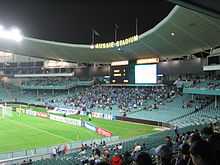Philip Cox
| Professor Philip Cox | |
|---|---|
| Born |
1 October 1939 NSW, Australia |
| Nationality | Australian |
| Alma mater | University of Sydney, University of New South Wales |
| Occupation | Architect |
| Practice | Cox Architects & Planners |
| Buildings | Sydney Olympics, Australian National Maritime Museum, Sydney Football Stadium, Flinders Park in Melbourne. |

Professor Philip Sutton Cox AO (born 1 October 1939) is an Australian architect. Professor Cox is the founding partner of Cox Architects & Planners, one of the largest architectural practices in Australia.
He commenced his first practice with Ian McKay in 1963, then, in 1967 he founded his own practice, Philip Cox and Associates. The firm has grown to become Cox Architects & Planners, which has 400 staff.[1] Professor Cox is responsible for projects throughout Australia and also in South-East Asia, China, the Middle East, South Africa and Europe, and he handles much of concept design for each project. He has been described as “epitomising the Sydney School of Architecture” in earlier projects.[2] His work has won him multiple awards, the first being in 1963, one year after graduating from the University of Sydney.
Early years
Philip Sutton Cox was born on 1 October 1939 to Ron and May Cox. He was their second child. He has one older sister, Judith Cox.
Philip Cox's childhood was comfortable, growing up in Killara on the North Shore in Sydney but he was born just one month after the start of the Second World War, which ended when he was six.
Cox attended Gordon Public School and then the Sydney Church of England Grammar School (Shore) in North Sydney. In his first years at Shore, art was taught by John Lipscombe, who had helped plan the new art block which had been praised by the architect Harry Seidler, who had lectured in the building in July 1952. Cox decided at quite an early age that he wanted to be an architect, though this was not clear until it was nearly time to leave school. He won a Commonwealth scholarship which was to pay his fees.[3]
Education
Cox studied at the University of Sydney between 1957 and 1962, where he was awarded a Bachelor of Architecture, then at the University of New South Wales between 1970 and 1975, where he was awarded a Doctorate of Science.[3]
Personal life
Philip Cox married Louise, a fellow architect, in Sydney in April 1972. They have two daughters, Charlotte and Sophie.[3]
Architectural work
Professor Philip Cox designed many of the city's iconic buildings including a number of the buildings used for the Sydney Olympics, the Australian National Maritime Museum at Darling Harbour and the Sydney Football Stadium. He also designed the Flinders Park tennis centre in Melbourne and Longitude 131 at Uluru. Cox was the architect responsible for initially implementing the American Radburn design for public housing in New South Wales.
Some of the projects across Victoria:
- North Melbourne station;
- College Chapel, Haileybury, Melbourne
- Hepburn Bath House and Spa, Daylesford;
- William Barak Bridge, Melbourne;
- National Institute of Circus Arts, Prahran;
- Richmond station upgrade;
- Chisholm Institute of TAFE, Building G, Dandenong;
- Craigieburn rail station;
- Roxburgh Park rail station;
- Cato Hall, Wesley College, Glen Waverley;
- City Library, Melbourne;
- Eureka Stockade Interpretive Centre;
- Chisholm Access and Language Program building, Frankston;
Awards
Cox has received numerous awards in recognition of his contribution to architecture, including:
- 1962 - prize of Royal Australian Institute of Architects;
- 1963 - John Sulman Medal – Ian McKay & Philip Cox – St. Andrews Presbyterian Church, Leppington;
- 1965 - John Sulman Medal – Ian McKay & Philip Cox – C. B. Alexander Presbyterian Agricultural College, Tocal Paterson, NSW;
- 1969 - Wilkinson Award Winner – Philip Cox & Associates Hawkins Residence, 19 Norma Crescent, Cheltenham;
- 1971 - Institutes of Valuers Prize, University of Sydney;
- 1983 - Sir Robert Matthew Award;
- 1984 - Royal Australian Institute of Architects Gold Medal, the Australian architecture profession's highest accolade;
- 1987 - Honorary Fellowship of the American Institute of Architects;
- 1987 - Life Fellowship to the Royal Australian Institute of Architects (RAIA);
- 1987 - Wilkinson Award Winner – Philip Cox Public Housing, Suite 8400 Newtown;
- 1988 - Awarded the Officer of the Order of Australia for services to architecture;
- 1989 - John Sulman Medal – Joint Winners, Philip Cox Richardson Taylor Partners – Sydney Exhibition Centre, Darling Harbour
- Sir Zelman Cowen Award for Public Buildings;
- 1993 - Sport and Architecture Award from the Olympic Committee;
- 1993 - Fellow of the Royal College of Humanities;
- 1993 - Received the inaugural award for Sport and Architecture from the International Olympic Committee in 1993;
- Past Vice President, Environment Board, Royal Australian Institute of Architects (RAIA), NSW Chapter;
- Past Member, Historic Buildings Committee, Cancer Patients Assistance Society of NSW;
- Vice President, Cancer Patients Assistance Society of NSW;
- Vice Chairman, Architecture and Design Panel, Visual Arts Board, Australia Council;
- Chairman of Education Board of the Royal Australian Institute of Architects, Federal Chapter.
References
- ↑ "COX Architects official website".
- ↑ "ULTIMATEHIDES website".
- ↑ 3.0 3.1 3.2 Philip Cox. Portrait of an Australian Architect, by Jennifer Towndrow, Penguin Books Australia, Published 1991.
Further reading
- "Cox Architects : selected and current works", By Philip Sutton Cox 1997;
- "Cox Architects & Planners" by Philip Sutton Cox, Stuart Harrison, Sandra Kaji-O'Grady, Anna Johnson, 2008.
- A decade in review: Philip Cox – Australian Design Review;
- - Philip Cox;
- "Australian Architects: Philip Cox", Royal Australian Institute of Architects, Canberra, 1984;
- "Australian Architects: Philip Cox, Richardson & Taylor", RAIA, Canberra, 1988.
External links
- - Philip Cox at Cox Architects;
- Philip Cox unleashed - ABC radio;
- Philip Cox and the Spirit of Place - ABC Radio;
